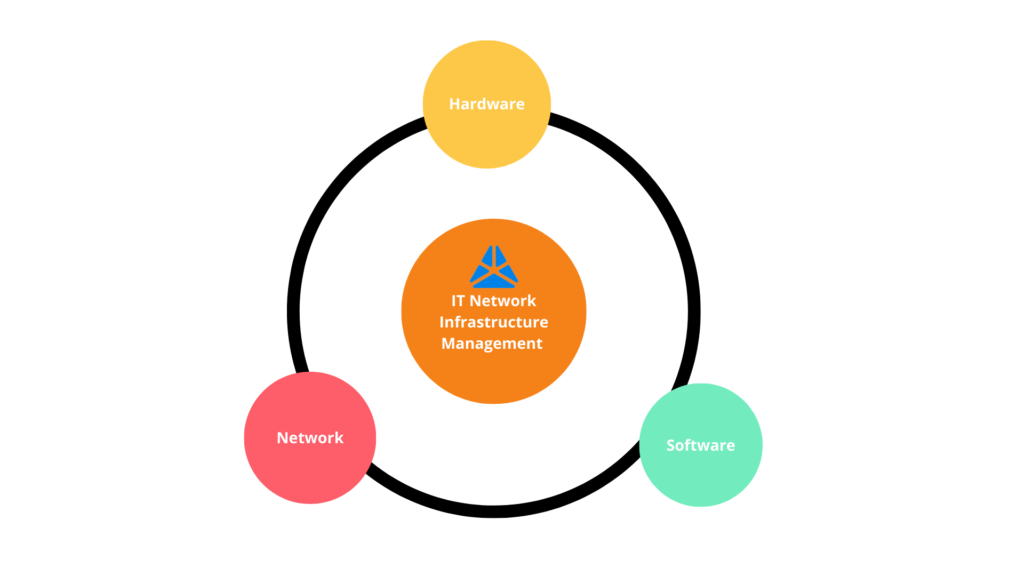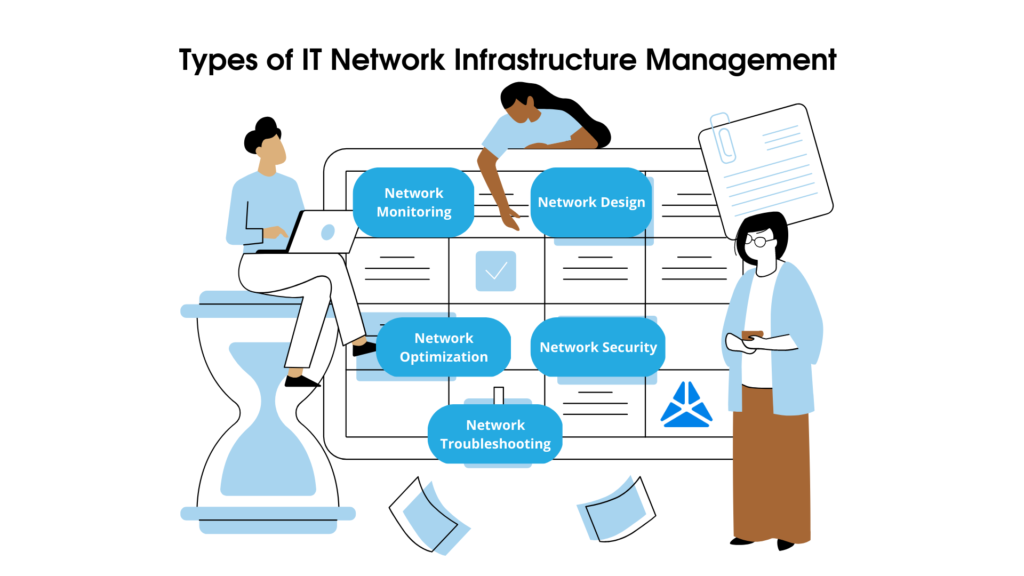
IT network infrastructure management means setting up, maintaining, and monitoring the hardware and software that make up a company’s network. This includes routers, servers, cables, and security systems. Network infrastructure specialists have only one goal — to make sure that everything (the network) works as it should and is secure, efficient, and interconnected.
Management of this complex system helps ensure that the network is operating properly and efficiently. Staff can monitor and resolve network problems quickly and effectively thanks to this strategy.
All of this makes network infrastructure management an essential part of any business or organization that relies on its computer network for communication, data storage, and other operations.
Let’s define some major tips on how to operate network infrastructure management properly to ensure a smooth company’s future expansion in this way.
What is IT Network Infrastructure?

The hardware and software components involved in creating a computer network are known as the IT network infrastructure. It includes the physical components – such as routers, switches, firewalls, and access points – as well as the software components, such as the operating system, applications, and security protocols. It is responsible for routing data, providing internet access, security and more. If IT network infrastructure wouldn’t exist, for example, businesses would be unable to communicate internally or with customers, process orders, manage inventory, and so on. Also, they would not be able to benefit from the numerous services offered by the Internet.
In short, an IT network infrastructure is necessary for any organization to effectively and efficiently operate. This concept also includes the management and network infrastructure monitoring tools needed to ensure that the network is up and running smoothly.
Let’s See What Types of IT Network Infrastructure Exist
To begin with, check out the types of IT network infrastructure.
- Wired Network Infrastructure: This type of infrastructure includes physical cabling, such as Ethernet cables, to connect computers and other devices.
- Wireless Network Infrastructure: This type of infrastructure relies on wireless technology to connect computers and other devices. Examples include Wi-Fi networks and Bluetooth connectivity.
- Cloud Network Infrastructure: Users can access and save data on remote servers that are hosted in the cloud thanks to this kind of infrastructure.
- Network Security Infrastructure: This type of infrastructure provides security measures to protect a network from malicious activities, such as cyberattacks. Examples include firewalls and antivirus software.
- Network Storage Infrastructure: This type of infrastructure allows users to store data and files on shared storage devices, such as file servers and NAS devices.
Why Does IT Network Infrastructure Need to be Managed?
IT network infrastructure needs proper management for several reasons. Correct operating helps to ensure a number success components in the network:
- security, reliability, and efficient work
- cost-reduction
- improved efficiency
- compliance with any applicable laws or regulations
- higher levels of customer satisfaction
- latest technology update in the network
- up or down scaling as needed
How to Manage an IT Network Properly
IT network infrastructure is supposed to be managed and monitored regularly to ensure that all parts are functioning correctly and securely. By properly maintaining and managing the infrastructure, businesses can ensure that their networks are secure, reliable, and cost-effective. This includes managing and monitoring network performance, security, data protection, and compliance with industry standards. Here are some crucial tips for effective network infrastructure management.

Monitor Network Performance
It is worth monitoring the network productivity to identify any problems or potential areas of improvement. You should always be sure that the network can handle all the traffic it receives and meet the changes in your business needs.
Implement Security Measures
Implementing security measures is critical to managing an IT network. Use firewalls, antivirus software, encryption, and other security measures to protect your network from malicious threats and ensure that all users are authenticated and authorized before accessing the network.
Conduct Data Protection and Compliance Audits
Regularly audit your network to ensure that data is being properly secured and that your organization complies with industry standards. Make sure that all data is encrypted and backed up regularly, and that all users follow appropriate access protocols.
Test and Upgrade Network Infrastructure
Test and upgrade the network infrastructure periodically to ensure that it is capable of handling the current and future needs of your business. Upgrade hardware, software, and applications as needed to keep your network running smoothly.
Develop an IT Network Strategy
Develop a comprehensive IT network strategy that outlines your organization’s goals and objectives. By establishing clear and measurable goals, your IT network strategy, you will ensure that the strategy aligns with the needs of the business and is developed with the right focus. Examples of goals and objectives may include improving customer experience, optimizing operations, or reducing costs.
Types of IT Network Infrastructure Management
Network Monitoring
Network monitoring involves keeping track of the performance of a network and its components. This includes monitoring data traffic, server performance, and network devices.
Network Security
Network security involves protecting the network from malicious attacks and unauthorized access. This includes implementing firewalls, antivirus software, and other security measures.
Network Design
Network design involves designing a network for a particular purpose. This includes selecting the correct type of hardware and software, choosing the best topology, and creating a logical diagram of the network.
Network Troubleshooting
Network troubleshooting involves identifying and solving problems with a network. This includes identifying the cause of the problem, determining the best course of action, and implementing a solution.
Network Optimization
Network optimization involves ensuring that a network is running as efficiently as possible. This includes making sure that the network is optimized for speed, latency, and reliability.
Why IT Network Infrastructure Management Is Supposed to be Outsourced
- Cost savings. Outsourcing network infrastructure management can save companies money by eliminating the need to hire, train, and maintain a staff of IT personnel. Additionally, companies may be able to take advantage of lower labor costs in countries with less expensive labor.
- Access to expertise. Outsourcing to an experienced provider can provide access to a team of IT professionals with specialized knowledge and experience in network infrastructure management. Additional expertise can ensure that the system is configured and managed in the most efficient and cost-effective manner.
- Increased security. By outsourcing network infrastructure management, companies can ensure that their system is up to date with the latest security measures and protocols. Additionally, experienced vendors can provide access to sophisticated security systems and malware detection tools, which can help protect the system from attacks.
- Increased scalability. An experienced provider can help companies manage their network infrastructure as they grow, ensuring that the system is able to handle increased traffic and additional users. Such scalability can also help reduce the need to invest in additional hardware or software.
- Reduced downtime. Companies can rely on experienced providers to quickly resolve any network issues and maintain uptime, ensuring that users can access the system whenever they need it. This can help reduce lost productivity and associated costs.
Why MWDN is the Best Partner for IT Network Infrastructure Management
MWDN offers remote support and management of IT network infrastructure. While our specialists with rich tech backgrounds efficiently manage IT infrastructure (starting with basic monitoring services to incident management services), our clients can focus on their business goals and objectives. Hiring specialists at MWDN, you opt for something more than just classical outsourcing – we introduce a model that allows better monitoring and managing team performance. Outstaffing gives customers the sense of an internal team with less price and shorter time frames. According to this model, you can hire a dedicated team or hire only the required specialists.
Our network infrastructure management services include:
- network planning
- design
- implementation, and support
- monitoring, maintenance, and troubleshooting services for networks
Our services are fully tailored to your specific IT infrastructure needs, minimizing downtime and providing secure and reliable network services.
Contact us to optimize your IT network and ensure it runs smoothly and securely.
Content
- 1 What is IT Network Infrastructure?
- 2 Let’s See What Types of IT Network Infrastructure Exist
- 3 Why Does IT Network Infrastructure Need to be Managed?
- 4 How to Manage an IT Network Properly
- 5 Types of IT Network Infrastructure Management
- 6 Why IT Network Infrastructure Management Is Supposed to be Outsourced
- 7 Why MWDN is the Best Partner for IT Network Infrastructure Management